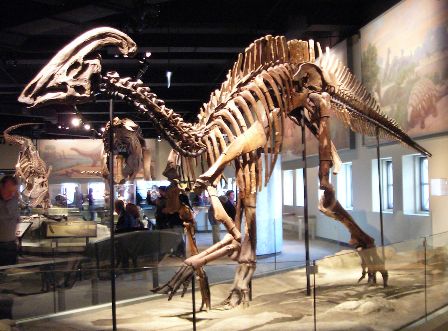- Series:Animals, Transcript English
Job 41:1, 30
“Canst thou draw out leviathan with an hook? or his tongue with a cord which thou lettest down? Sharp stones are under him: he spreadeth sharp pointed things upon the mire.”
Before the Great Flood of Noah, what did our forefathers see when confronted with a dinosaur? What did dinosaur skin look like? What were their babies like? Biblical history places the creation of the great land living dinosaurs on the same day as man was created. That means that there is little doubt that at least some of the people we read about in the Bible saw dinosaurs. Many modern creationists think that Job’s description of leviathan actually describes some sort of dinosaur.
 For generations, what we knew, or thought we knew, about dinosaurs was a result of studying their bones. But now, discoveries are offering some surprises about what dinosaurs actually looked like. One discovery is the first ever fossilized impression of the skin of a duckbilled dinosaur known as a hadrosaur. This interesting fossil, found in southwest New Mexico, shows that the hadrosaur had bumps on its skin that averaged a little over half an inch in diameter. Each rose next to each other like little mountains. This means, as one scientist put it, that if you were to pet a hadrosaur, it would feel like running your hand over a mountain bike tire.
For generations, what we knew, or thought we knew, about dinosaurs was a result of studying their bones. But now, discoveries are offering some surprises about what dinosaurs actually looked like. One discovery is the first ever fossilized impression of the skin of a duckbilled dinosaur known as a hadrosaur. This interesting fossil, found in southwest New Mexico, shows that the hadrosaur had bumps on its skin that averaged a little over half an inch in diameter. Each rose next to each other like little mountains. This means, as one scientist put it, that if you were to pet a hadrosaur, it would feel like running your hand over a mountain bike tire.
In Patagonia, scientists have discovered the first known embryos, complete with skin impressions, of a sauropod, which was a large, four footed dinosaur. These discoveries are giving us a more accurate picture of what these living monuments to God’s power and creativity looked like. And one day we can ask Job exactly what leviathan was.
Prayer:
Father, I thank You because Your power and Godhead are evident in the creation around us. In Jesus’ Name. Amen.
Notes:
R. Monastersky, “Getting under a dinosaur’s skin”, Science News, 1/16/99, v. 155, p. 38. Photo: Mounted skeleton of Parasaurolophus cyrtocristatus, Field Museum of Natural History. Courtesy of Lisa Andres. (CC-BY-SA 2.0 GENERIC)
